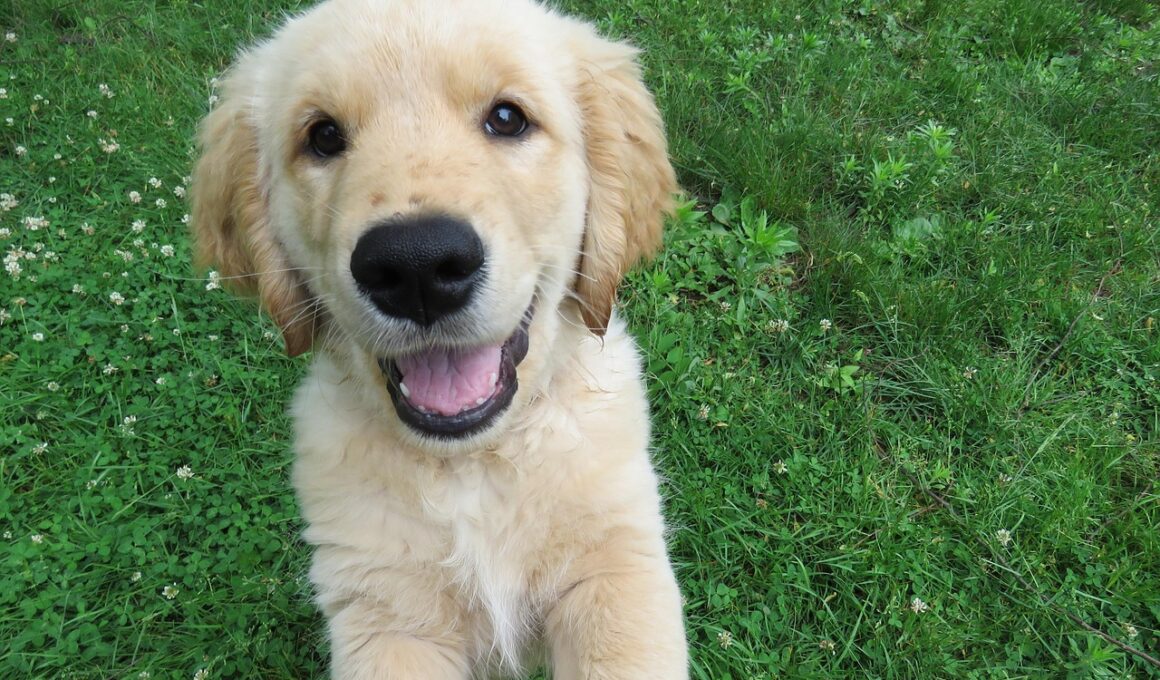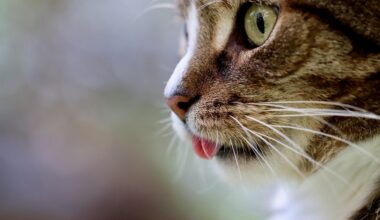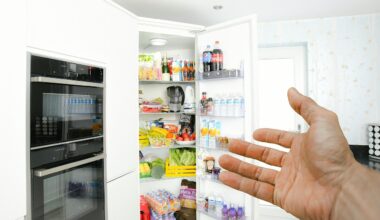Behavioral Tips for Puppies That Jump Too Much
Puppies are naturally energetic creatures, and jumping is one way they express their excitement. While this behavior might seem adorable at first, it can quickly become overwhelming for owners. It is crucial to understand that jumping is often a sign of an eager and untrained puppy. To manage this behavior, provide a structured environment and redirect the puppy’s energy into more positive activities. Establish rules for greeting visitors, teaching your puppy to sit before getting attention, which helps minimize jumping. Consistency is key—ensuring everyone follows the same rules prevents confusion for the puppy, allowing them to learn more effectively. Additionally, rewarding calm behavior, rather than jumping, reinforces the behavior you want to see. Training sessions can be short but frequent, keeping your puppy engaged while learning. Introducing toys or engaging in play immediately before visitors arrive can help tire your puppy out and reduce the likelihood of jumping. Ensuring that socialization with other dogs and people is controlled can also play a significant role in reducing this behavior.
Another effective method to curb jumping is to implement a “no touch” command that the puppy can associate with jumping. Teaching this command requires patience and practice. When your puppy jumps up, ignore them until they are calm and back on all fours. When they are settled, immediately give praise and reward them with treats. This positive reinforcement teaches your puppy that calm behavior garners affection and attention, while jumping does not. Gradually, your puppy will learn that staying on the ground is a more successful way to receive affection. Engage different family members and friends in this practice to increase the variety of responses your puppy receives. The key is consistency; thus, ensuring everyone understands how to reinforce this command is essential for success. Always make training sessions fun and rewarding. Incorporating basic commands like “sit” or “down” alongside jump prevention will enrich your puppy’s training experience. Incorporate playtime into these sessions to keep the puppy engaged. Also, remember, patience and persistence are vital; training a young puppy takes time and dedication.
Socialization and Interaction
Socialization plays a crucial role in managing your puppy’s jumping behavior. By exposing your puppy to a variety of environments, people, and other animals, you help to develop their comfort levels in different situations. Start by arranging playdates with other well-behaved, vaccinated dogs. This exposure teaches your puppy appropriate ways to greet and interact without excessive jumping. Also, consider enrolling your puppy in puppy classes to provide them with structured exposure to new stimuli. Classes focus on foundational commands, social interaction, and obedience, making them excellent for young dogs. Structured environments with supervised interactions are less chaotic, allowing your puppy to learn gradually and appropriately. Furthermore, during these socialization opportunities, emphasize calm interactions by asking guests to ignore your puppy until they calm down fully. Repeated exposure to similar situations will help reduce the anticipation that leads to jumping. Be mindful of the environments where you introduce your puppy. Avoid overwhelming situations that might heighten their excitement. With time, your puppy will learn to greet people appropriately and feel more secure in various environments.
Managing jumping behavior also involves understanding the underlying reasons for this behavior. Puppies jump for attention, excitement, or even anxiety. Identifying the triggers that lead to jumping can help you tailor your training approach. Keeping a journal of your puppy’s behavior can provide insights into patterns and potential areas of stress. If your puppy jumps when they see new people or animals, create a controlled entry scenario where they can gradually adjust before interactions occur. This gradual exposure allows the puppy to decrease their excitement level leading up to the encounter. Use calming techniques before potentially anxious situations, such as soothing voice commands or gentle petting. Additionally, consider physical exercise to help expel some excess energy before guests arrive or situations that elicit jumping. Taking your puppy for a long walk or engaging in vigorous play can significantly reduce added excitement when greeting others. Striking a balance between energy levels and relaxation can significantly minimize jumping incidents. Understanding your puppy’s unique personality will help tailor your approach more effectively.
Setting Boundaries at Home
Setting boundaries within your home is crucial for managing your puppy’s jumping behavior. Establish specific areas where the puppy feels comfortable while keeping them away from chaos-prone zones. Utilizing gates can help you maintain these boundaries effectively. In areas where guests enter, practice having your puppy in a separate room before visitors arrive. This can prevent them from jumping all over guests as they enter, helping establish a calm greeting atmosphere. Training your puppy to settle in a designated space, such as their bed or crate, during high-traffic times can inhibit excessive excitement. Place toys or a favorite blanket in these areas to promote relaxation. Always reward your puppy for good behavior when they remain calm in these zones. Reinforce their sense of security by spending quality time with them in these spaces when the house is less busy. Consistent routines can regulate their expectations and help them remain calm during guest interactions. Remember, early boundaries set the foundation for lifelong habits beyond initial training sessions.
Finally, it is essential to consider the energy levels and needs of the specific breed of your puppy since various breeds may have different tendencies regarding jumping. High-energy breeds such as Border Collies will require more exercise, stimulating activities, and mental challenges to keep them content. Conversely, smaller or less active breeds may need different approaches. Tailoring your training and activity levels to meet the specific needs of your puppy’s breed can produce better results in managing jumping behavior. Comprehensive breed research can provide you with insights into behaviors typical for your puppy’s genetic background. Connect with experienced trainers or veterinarians who understand breed-specific training strategies. Local dog clubs can also serve as a resource for specific breed training techniques. Engage with the wider dog-owning community to gather valuable insights, share experiences, and learn best practices for nurturing your puppy’s development. Taking the time to understand breed traits will benefit your training journey and foster stronger relationships with your dog.
Conclusion and Ongoing Support
In conclusion, managing a puppy’s jumping behavior requires a mix of training, consistency, and socialization to achieve positive results. Employing the various methods discussed—such as creating structured greetings, rewarding calm behavior, and establishing boundaries—will reinforce the desired behaviors in your puppy. Begin incorporating these practices as part of your daily routine. Monitor progress, and always remain patient and positive. Take note of progress but also be prepared for setbacks along the way, as learning takes time. It might be beneficial to connect with professional trainers or dog behaviorists if you feel overwhelmed or struggle to make progress. They can provide personalized guidance and training strategies. Remember, every puppy is unique, and what works for one may differ for another. Ensure to celebrate small victories to maintain motivation for both you and your puppy. Ultimately, a well-trained puppy grows to be a well-adjusted adult dog, and investing time and effort in their early development will yield a fulfilling companionship for many years to come.
By implementing these techniques, you nurture a respectful relationship with your puppy where they learn acceptable behaviors and, in turn, enhance your bond through positive experiences. Train consistently and keep the training environment stress-free, ensuring a happy learning space for your dog. Celebrate successes with lots of praise and treats, as this encourages them to repeat the preferred behavior. Remember to maintain an upbeat attitude to inspire your little friend. Engage in regular play, exercise, and mental stimulation to alleviate excess energy. Well-exercised puppies exhibit calmer behaviors, aiding in their enthusiasm for learning new commands. Every dog jumps; the goal is to ensure they do it appropriately under certain conditions. Knowing how much your puppy loves to jump and incorporating healthy boundaries guarantees that their joyful spirit is maintained while steering away from excessive behavior. With time, dedication, and the right techniques, you will guide your puppy to learn better ways of expressing excitement. By fostering self-control and providing a nurturing environment, your puppy will grow into a well-adjusted adult dog, making you proud as they demonstrate their learned behaviors in public settings.


